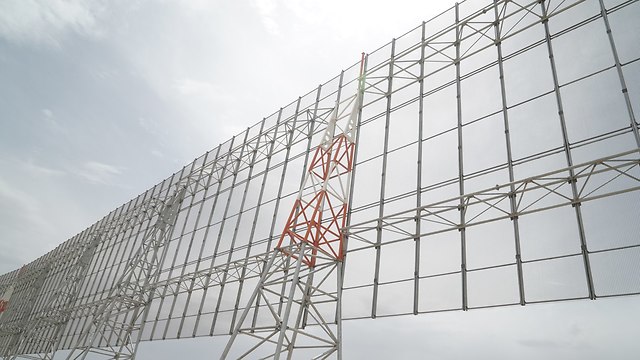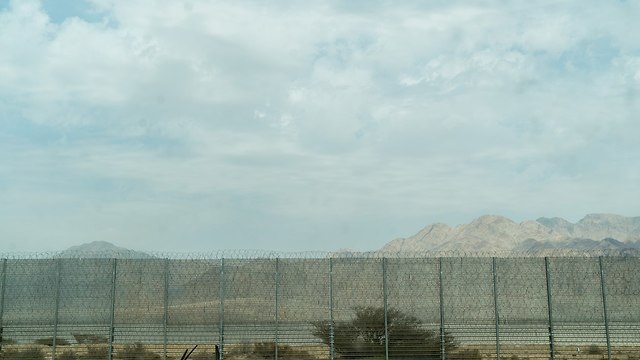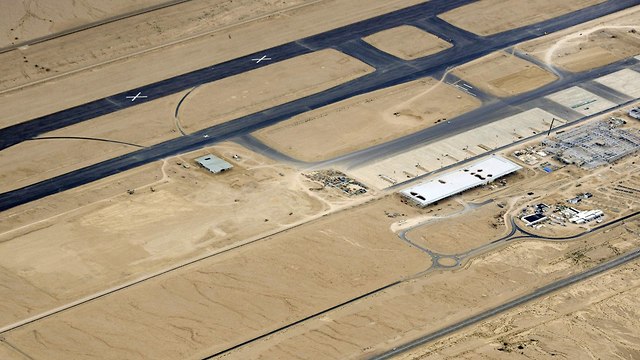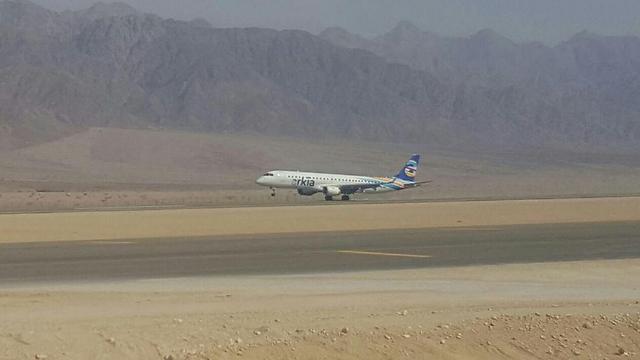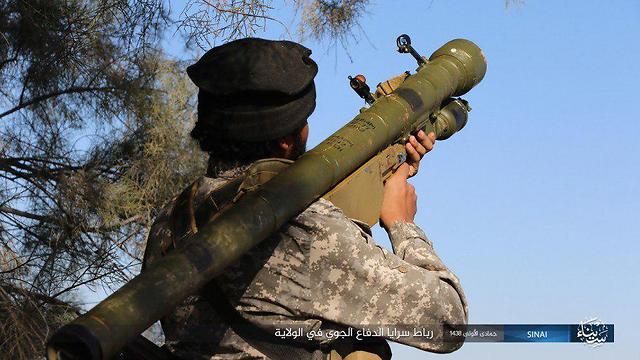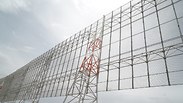

A peak at defense measures surrounding new Ramon Airport
In anticipation of opening of new international Arava airport in 2019, a 34km long physical barrier is in the final stages of construction; steel plates, 26m high fence, communication points and full cooperation with Jordan will assist IDF in preventing terror groups such as Islamic State from attacking planes.
The airport, named after the late Israeli astronaut that perished in the Columbia shuttle explosion and expected to be opened in March, 2019, will be defended by 34 kilometers of physical and intelligence barriers running from Eilat to the Samar kibbutz in southern Arava.
Visiting the outskirts of the airport, from which hundreds of international flights will be operated every year, shows just how near to the Jordanian border its landing strips are—a volley of gunfire or an antitank missile away.
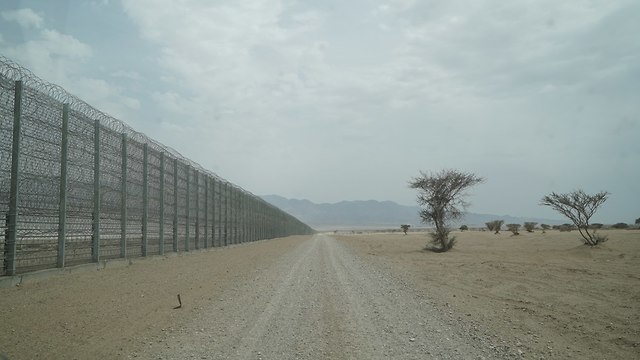
Its sensitive location, however, necessitated careful preparations by the defense establishment. Despite the strength of the Jordanian army on the other side of the border, Israel's relatively good coordination with it and the low security risk compared to the Sinai front—where more than 1,000 Islamic State terrorists are active—the IDF took no chances.
Unlike the five meter high wall on the Egyptian frontier, a six meter tall stainless steel fence was erected near the airport, which includes 35 millimeter thick, impregnable steel slabs with additional plates being installed underground to prevent the fence being pulled down by a vehicle.
The fence's posts have been planted six meters deep into the ground and placed in concrete castings, since the nature of the Arava's earth required such fortifications. The width of the fence, 35 microns, is three times that of the Egyptian border fence.
Another enormous fence was erected between the border itself and runways, out of fear of advanced Kornet antitank missiles being fired at aircrafts taking off from the airport. The second fence is four and a half kilometers long and 26 meters high and it contains 186 columns and three million screws, weighing in at 6,500 tons of steel.
'Even an APC wouldn't be able to breach it'
A senior IDF official with knowledge of the barrier's creation said it was the tallest in the country, "and from what we've seen the tallest in the world as well."
"We held a fire test to make sure it covers every angle of antitank fire, while the air force provides a different solution for the threat of shoulder-mounted antiaircraft missiles. As for the fence, even an armored personnel carrier ramming it will not be able to breach it," he stated.
"A similar fence will be erected opposite the Gaza Strip in three months' time," he added. "At certain points, such as the Besor Stream in the southern strip, we've already put up a portion of the fence."
In addition to the physical barriers, intelligence devices were dotted in three separate communications hubs, with 64 meter high masts used by police, Shin Bet, IDF and other bodies and affixed with radars and cameras scanning deep into Jordan while also affording a 360 degree view of the Israeli side of the border.
The cost of the Jordan barrier project is NIS 288 million, with no plans in place at the moment to extend it farther north up to the Masada, where an old fence begins that reaches as far as the tri-border area in Hamat Gader.
Instead, Israel is constructing a similar barrier within Jordanian land to head off an Islamic State offshoot in the southern Syrian Golan Heights, which poses a potential threat to both Israel and Jordan.
Nevertheless, the remainder of Israel's frontier with Jordan will remain fenceless, as the area has seen no attempts at a terrorist attack in years. Attempts at crossing the fence, mostly of a criminal nature or as part of work migration, were however noted.
To secure the new fence, thousands of old mines—mostly anti-personnel—were removed from 17.5 kilometers of the southern Arava border. In order to prevent the new fence being destroyed or breached by floods, 56 low-water crossings and lattices were created at the bottom of the fence that may be manually opened on days of inclement weather, allowing rainwater to flow through harmlessly.
Apart from the new barrier, standing army infantry forces regularly patrol the sector, including soldiers from the co-ed Bardelas Battalion and other teams from elite units. Furthermore, the aforementioned cooperation with the Jordanians is considered a strategic asset, with the IDF saying they are highly effective when tackling what few incidents occur in the sector.
A senior Southern Command officer spoke on the Israeli-Jordanian work, saying that the airport's creation was accompanied by working in conjunction with Israel's neighbor throughout.
"We saw what happened at the Sharm airport that was all but abandoned after the downing of a Russian plane (by the Islamic State in 2015). Merely firing at a plane taking off from Ramon, without even hitting it, will send all of the immense investment down the drain," he cautioned.
"What we created here is a sort of insurance policy with the foreign air carriers landing in the airport," he explained.
Another reason for the bi-national cooperation was ensuring calm in a region heavily visited by tourists on both sides of the border. This past January, for instance, Israeli security forces drilled a scenario of terrorists coming in from the sea to Eilat and going on a killing spree in one exercise and heavy rocket fire at the Eilat bay in another.
The Shin Bet divulged last week that a group of eight Bedouin drug traffickers from the Negev were arrested and charged. The group was involved in a large scale smuggling attempt near Nitzana, in the western Negev.
During their smuggling attempt, the Bedouins damaged a highly sensitive security infrastructure, causing the border fence's surveyors to lose visibility for several hours.
The IDF noted that the fault had since been fixed, and a new, sophisticated measure was deployed to prevent such a grave incident from reoccurring.
Some 100 army observers are active in four intelligence-collection operation rooms.
Fear of ISIS
Fears of an Islamic State terror attack are still running high in the Arava, as the terror group is still a thorn in the side of the Egyptian military, situated sometimes mere kilometers away from the Israeli border.
The IDF is therefore preparing for a scenario of multi-pronged infiltration, with no prior intelligence forewarning and dozens of terrorists armed with handguns, machineguns, antitank missiles, antiaircraft missiles and other armaments.
Such an infiltration may even take the form of an orderly military-style invasion, as the terror group has already conducted in the past few months on Egyptian bases in the peninsula, in which dozens of soldiers were killed—including senior officers.
Criminal smuggling operations on the border, meanwhile, are continuing, at a frequency of two to three times a week on occasion. The IDF and Border Police respond to every such attempt in an effort to foil it, but the IDF has maintained an attitude saying that wherever those smugglers operate, the Islamic State will stay away.














